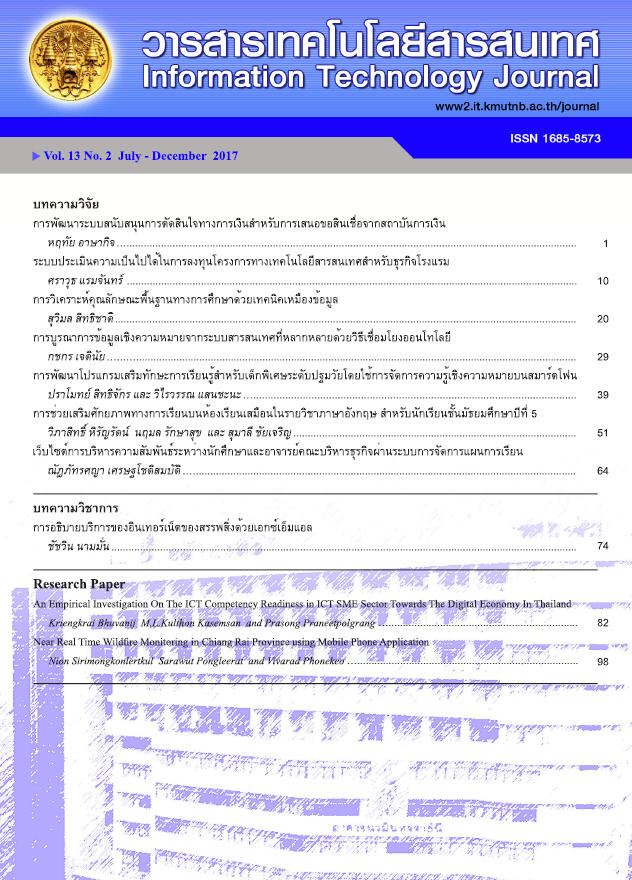การช่วยเสริมศักยภาพทางการเรียนบนห้องเรียนเสมือนในรายวิชาภาษาอังกฤษ สำหรับนักเรียนชั้นมัธยมศึกษาปีที่ 5
Main Article Content
Abstract
การวิจัยนี้มีวัตถุประสงค์เพื่อศึกษาความถี่ของการใช้การช่วยเสริมศักยภาพทางการเรียนและผลสัมฤทธิ์ทาง การเรียนของผู้เรียนที่เรียนด้วยการช่วยเสริมศักยภาพ
ทางการเรียนบนห้องเรียนเสมือน รายวิชาภาษาอังกฤษ สำหรับนักเรียนชั้นมัธยมศึกษาตอนปลาย กลุ่มตัวอย่างเป็นนักเรียนชั้นมัธยมศึกษาปีที่ 5 โรงเรียนคอนสวรรค์ จังหวัดชัยภูมิ สำนักงานเขตพื้นที่การศึกษามัธยมศึกษา เขต 30 ภาคเรียนที่ 2 ปีการศึกษา 2557 จำนวน 75 คน เครื่องมือที่ใช้ในการวิจัย ได้แก่ ห้องเรียนเสมือน และแบบทดสอบวัดผลสัมฤทธิ์ทางการเรียน ผลการวิจัยพบว่า ผู้เรียนใช้การช่วยเสริมศักยภาพทางการเรียนด้านความคิดรวบยอดมากที่สุด (ร้อยละ 21.97) รองลงมาคือด้านกระบวนการ (ร้อยละ 20.98) ด้านส่งเสริมการคิดสร้างสรรค์ (ร้อยละ 19.30) ด้านกลยุทธ์ (ร้อยละ 19.15) และด้านการรู้คิด (ร้อยละ 18.60) ตามลำดับ นอกจากนี้ยังพบว่าผู้เรียนที่เรียนด้วยห้องเรียนเสมือนที่พัฒนาขึ้นมีผลสัมฤทธิ์ทางการเรียนหลังเรียนสูงกว่าก่อนเรียนอย่างมีนัยสำคัญทางสถิติที่ระดับ .05 และผู้เรียนมีคะแนนเฉลี่ยจากการทำแบบทดสอบหลังเรียนคิดเป็นร้อยละ 68.54 ซึ่งสูงกว่าเกณฑ์ร้อยละ 60 อย่างมีนัยสำคัญทางสถิติที่ระดับ .05
The objectives of this research were to study the frequency for use of the type of scaffolding and to study students’ learning achievement who studied with virtual classroom with scaffolding. The sample for this study consisted of 75 upper secondary school students from Matthayomsuksa 5 of Khonsawan School, Chaiyaphum Province (THAILAND), and Secondary Educational Service Area Office 30 (SESAO) in the second semester of the academic year 2014. The experimental tools were virtual classroom with scaffolding and achievement tests. The result was shown that most students used to type of scaffolding: the first conceptual scaffolding (21.97%), procedural scaffolding (20.98%), creative scaffolding (19.30%), strategic scaffolding (19.15%), and the last meta-cognitive scaffolding (18.60%). Also, it’s found that the students’ post- achievement scores statistically higher pre- achievement score (p<.05) and percentage of students’ post- achievement scores was 68.54, which was higher than the regular criteria (60%) at .05 level of significance.


